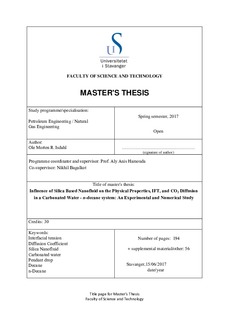| dc.contributor.advisor | Hamouda, Aly | |
| dc.contributor.author | Isdahl, Ole Morten | |
| dc.date.accessioned | 2017-10-26T08:41:40Z | |
| dc.date.available | 2017-10-26T08:41:40Z | |
| dc.date.issued | 2017-06 | |
| dc.identifier.uri | http://hdl.handle.net/11250/2462285 | |
| dc.description | Master's thesis in Petroleum engineering | nb_NO |
| dc.description.abstract | Carbonated water injection (CWI) for enhanced oil recovery (EOR) overcomes mobility issues, macroscopic bypassing and sweep efficiency limitation of conventional CO2 injection. It might also lead to reconnection of trapped or water blocked residual oil due to oil swelling. Molecular diffusion is a crucial and consequential process during CWI and carbon storage in subsurface geological structures. EOR, utilising nanotechnology have a potential for altering oil reservoirs to more water-wet, but it is also a high possibility that the combination of nano-EOR and CWI may increase the mass transfer rate (diffusion) of CO2 into residual oils. Diffusion experiments have been carried out by the pendant-drop method together with numerical modelling to investigate the influence of silica nanofluid (NF) in a CW-n-decane system. Experiments have been carried out at 25°C and 45°C, 10-90 bar, for three concentrations (0.05, 0.5 and 1.0 g/l) of water-based silica NF, and one concentration (1 g/l) of synthetic sea water-based NF. P-T regions of gaseous, liquid and supercritical CO2 have shown to be important to understand, where unexpected results of increased interfacial tension (IFT) and decreased diffusion coefficient (D) with an increase in pressure have been validated by two methods. Transition from gaseous to both supercritical and liquid state reverse this trend for D. Transition from gaseous to liquid reverse it dramatically for IFT, and it is found that density difference of the phase is predominantly affecting this property. The viscosity of the drop is counterintuitively shown to increase with temperature because of the CO2 mass-transport into the n-decane, where the effect of increased solubility of CO2 in the water with lower temperature is dominant to the direct effect of temperature on viscosity. Carbonated NF showed to improve swelling relative to CW. A possible optimum concentration for improving EOR properties in the CWI-process is found with 0.5 g/l water-based NF, suggested to be caused by solubility improvement of CO2 in water, and generating a greater concentration gradient. The findings might indicate that coupling of nano-EOR and CW-EOR could enhance both oil recovery and CO2 storage. | nb_NO |
| dc.language.iso | eng | nb_NO |
| dc.publisher | University of Stavanger, Norway | nb_NO |
| dc.relation.ispartofseries | Masteroppgave/UIS-TN-IPT/2017; | |
| dc.subject | petroleumsteknologi | nb_NO |
| dc.subject | petroleum engineering | nb_NO |
| dc.subject | Interfacial tension | nb_NO |
| dc.subject | silica | nb_NO |
| dc.subject | nanofluid | nb_NO |
| dc.subject | carbonated water | nb_NO |
| dc.subject | pendant drop | nb_NO |
| dc.subject | decane | nb_NO |
| dc.subject | n-decane | nb_NO |
| dc.subject | CWI | nb_NO |
| dc.subject | nano-EOR | nb_NO |
| dc.subject | EOR | nb_NO |
| dc.subject | CCS | nb_NO |
| dc.subject | diffusion coefficient | nb_NO |
| dc.subject | produkjsonsteknologi | nb_NO |
| dc.subject | reservoarteknologi | nb_NO |
| dc.title | Influence of Silica Based Nanofluid on the Physical Properties, IFT, and CO2 Diffusion in a Carbonated Water - n-decane system: An Experimental and Numerical Study | nb_NO |
| dc.type | Master thesis | nb_NO |
| dc.subject.nsi | VDP::Teknologi: 500::Berg‑ og petroleumsfag: 510::Petroleumsteknologi: 512 | nb_NO |
